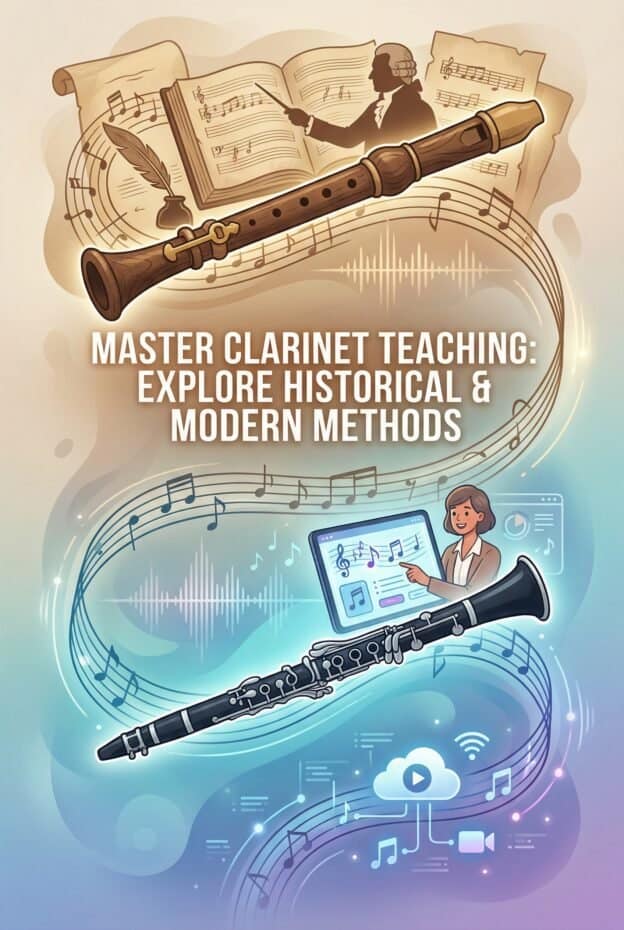Clarinet teaching methods are the collection of historical and modern approaches used to develop tone, technique, musicality, and improvisation on the clarinet. They span mentorship-era ear-based learning in the 18th century, conservatory-style French School focus on tone and legato, 20th century jazz improvisation techniques, and 21st century technology-enabled practice tools.
Overview: Clarinet Teaching Methods Through the Centuries
Clarinet teaching methods trace a clear path from 18th century oral mentorship to 21st century digital instruction. Each era adds tools for teachers: structured exercises, etudes, conservatory repertoire, jazz language, and now apps. Understanding this timeline helps teachers choose methods that match student goals, from classical auditions to jazz improvisation.
In the 18th century, most clarinetists learned by imitation from local players and court musicians. The 19th century brought method books, standardized fingerings, and composers like Carl Maria von Weber writing demanding parts that forced more systematic training. By the early 20th century, conservatories and jazz scenes created parallel but overlapping pedagogies.
Teachers today can combine these traditions: French School tone concepts, German and Central European technical rigor, American jazz ear training, and digital feedback tools. The challenge is not lack of material, but choosing what to prioritize for each student and turning historical ideas into concrete weekly lesson plans.
18th-19th Century: Mentorship, Hermstedt, and the Rise of Structured Pedagogy
In the late 18th century, clarinet teaching relied on apprenticeship-style mentorship. Students learned by ear, copying their teacher's tone, fingerings, and ornamentation. Written methods were rare, and regional styles in cities like Dresden, Paris, and Vienna shaped local playing traditions more than any single book.
Johann Simon Hermstedt, active in the early 19th century, illustrates the shift toward structured pedagogy. As a virtuoso in Germany and a close collaborator of Carl Maria von Weber, Hermstedt pushed clarinet design and technique forward. His demands for extended range and agility influenced instrument makers and forced teachers to address new technical challenges systematically.
Teachers can translate this mentorship-to-structure transition into modern lessons by pairing imitation with written material. Start each concept with modeling and echoing, then reinforce with notated exercises. For example, introduce a new articulation pattern by call-and-response first, then assign a short written study that uses the same pattern in all registers.
Instrument anatomy also began to matter more pedagogically in this period. As keywork expanded and the bore evolved, teachers had to address cross-fingerings, venting, and hand position. When a student struggles with 12th jumps or throat tones today, it echoes the same issues Hermstedt and his contemporaries faced on evolving 19th century instruments.
19th-20th Century: Weber, Conservatory Repertoire, and the Emergence of Etudes
Carl Maria von Weber's concertos and concertino, written in the early 19th century, became benchmarks for clarinet technique and expression. Their demands on legato, articulation, and altissimo range pushed teachers toward more organized technical training and clearer progression from simple pieces to virtuosic repertoire.
By the late 19th and early 20th centuries, conservatories in Paris, Brussels, and other European centers formalized clarinet curricula. Etude collections by Cyrille Rose, Hyacinthe Klosé, and Ernesto Cavallini emerged as core teaching tools. These etudes mapped specific technical goals to short, focused pieces, making it easier for teachers to assign targeted work.
For modern teachers, the key is to connect each etude to a precise skill. For example, Rose 32 Etudes No. 1 can be labeled as a legato and breath-control study, while Cavallini Caprices often target articulation and large interval leaps. Write the technical focus directly in the student's notebook so practice always links to a clear outcome.
Instrument design stabilized in this era into systems like the Boehm and Oehler clarinets. This standardization allowed method authors to assume consistent fingerings and keywork, which in turn made progressive method books more reliable. Teachers today benefit from this legacy when they sequence beginner methods, intermediate etudes, and advanced concert repertoire.
The French School: Tone, Smooth Legato, and the Paris Conservatory Influence
The French School of clarinet playing, centered on the Paris Conservatory, is defined by focused tone, smooth legato, and elegant phrasing. Teachers like Hyacinthe Klosé and later Louis Cahuzac and Jacques Lancelot shaped a lineage that still influences tone concepts worldwide, especially in North America and Western Europe.
Pedagogically, French School teaching emphasizes embouchure stability, consistent air support, and smooth register transitions. Teachers often use long-tone routines that move by half steps, focusing on even color across the chalumeau, clarion, and altissimo registers. The goal is a singing tone that blends easily in orchestral and chamber settings.
To translate this into lesson plans, assign daily long tones with specific instructions: start at written low E, crescendo to mezzo-forte over 4 beats, then decrescendo back to piano over 4 beats. Repeat on each chromatic step up to high C. Ask students to record one register each week and compare tone evenness using headphones.
Instrument anatomy plays a direct role in French School tone. Teachers focus on reed and mouthpiece interaction, encouraging reeds that vibrate freely but do not collapse under air pressure. A practical diagnostic: if a student has a thin or unstable tone, check reed strength, mouthpiece placement (about half the reed visible), and jaw pressure before changing anything in the fingers.
Jazz Clarinet Pedagogy: Improvisation, Ear Training, and Rhythmic Development
Jazz clarinet pedagogy developed in parallel with classical conservatory methods in the early 20th century. Players like Benny Goodman, Artie Shaw, and later Buddy DeFranco modeled a different skill set: flexible tone, strong swing feel, and fluent improvisation over chord changes. Teaching shifted toward ear training and rhythmic nuance.
Modern jazz clarinet teaching often starts with blues and modal frameworks. A common progression is 12-bar blues in concert F, then ii-V-I progressions in major keys. Teachers can introduce call-and-response improvisation in lessons, where the teacher plays a two-bar phrase and the student answers with a variation using the same rhythm or contour.
Rhythmic development is central. Use a metronome or play-along tracks at slow tempos, such as quarter note = 60, and have students clap, sing, then play swing eighth-note lines. Emphasize subdivision and off-beat accents. Apps that display visual subdivision can reinforce internal pulse and help students lock in with rhythm sections.
Ear training bridges jazz and historical mentorship traditions. Assign weekly transcription of short phrases from recordings by Benny Goodman or Sidney Bechet. Even 4-bar licks can teach articulation, vibrato style, and phrasing. Encourage students to write the lick in all 12 keys, then use it in their own solos over standard progressions.
Core Technical Focus Areas: Tone, Articulation, Breathing, and Etudes
Across all historical schools, effective clarinet teaching converges on four core areas: tone, articulation, breathing, and etudes. These pillars support both classical and jazz goals, from orchestral excerpts to small-group improvisation. Teachers who plan around these areas can adapt quickly to individual student needs and ensemble requirements.
Tone work begins with embouchure and air. Guide students to form a firm but flexible embouchure with corners forward and chin flat, then blow warm, steady air. Use a tuner or app to check pitch stability on long tones. If the pitch sags, coach stronger, faster air and lighter jaw pressure before changing equipment.
Articulation teaching should cover legato, staccato, and stylistic variations. Start with legato tonguing on repeated notes at slow tempos, such as quarter note = 60, focusing on minimal tongue movement. Progress to scale patterns with varied articulation, like slur-two-tongue-two, to connect tongue motion with finger coordination.
Breathing and phrasing benefit from concrete targets. Have students count how many beats they can sustain a comfortable mezzo-forte long tone at quarter note = 60. Set goals by level, such as 8 beats for beginners, 16 for intermediates, and 24 or more for advanced players. Track these metrics every few weeks to show progress.
Etudes tie everything together. Choose collections that match student level and goals: simple melodic etudes for beginners, Rose 32 or 40 Studies for intermediate classical players, and jazz etudes or transcriptions for improvisers. Always label each etude with a primary focus, such as “tone in throat tones” or “staccato in upper clarion.”
Practical Lesson Plans and Exercises (Beginner -> Advanced)
Effective clarinet teaching methods turn history into clear weekly structures. A 30-minute beginner lesson might include 5 minutes of breathing and mouthpiece-only work, 10 minutes on basic fingerings and simple tunes, 10 minutes on rhythm and counting, and 5 minutes reviewing instrument care and reed rotation habits.
For beginners, use exercises like 4-beat long tones on G, A, B, then simple 5-note scales. Add echo games where the teacher plays a 2-note pattern and the student copies by ear. This mirrors 18th century mentorship while building reading skills through simple method-book pieces with clear rhythmic notation.
Intermediate lessons of 45 minutes can shift to a structure like: 10 minutes tone and articulation, 15 minutes scales and technical patterns, 15 minutes etudes or repertoire, and 5 minutes sight-reading. Assign major scales in at least two octaves, plus one etude that targets a current weakness, such as uneven slurs or choppy staccato.
Advanced students, especially those preparing for auditions, benefit from 60-minute lessons with clear segments: 15 minutes fundamentals, 20 minutes etudes, 20 minutes repertoire (Weber, Mozart, Debussy, or jazz standards), and 5 minutes recording review. Encourage them to record at least one excerpt per week and bring notes on what they hear in tone, pitch, and rhythm.
Across levels, build in short diagnostic routines. Start each lesson with a 2-minute scale or arpeggio check in a different key each week. Listen for finger coordination, tone consistency, and articulation clarity. Use the findings to adjust the rest of the lesson plan in real time, focusing on the most pressing technical issue.
Technology in Modern Clarinet Instruction: Apps, Online Lessons, and Feedback
21st century clarinet teaching methods increasingly include technology, but fundamentals must stay central. Apps and online tools can provide objective feedback on intonation, rhythm, and recording quality, while video platforms allow students to study historical performances and modern masterclasses between lessons.
For rhythm, metronome apps with subdivision and accent features help students internalize complex patterns. Encourage practice with click on beats 2 and 4 for swing feel, or only on beat 1 for advanced pulse control. Some apps track time spent practicing at target tempos, giving teachers data to discuss consistency and focus.
Intonation apps that show real-time pitch tendencies are useful for long-tone practice. Have students sustain notes while watching the tuner, then experiment with reed placement, voicing (tongue position), and air speed to correct sharp or flat tendencies. This ties directly to historical tone work from the French School, now with visual confirmation.
Video recording is one of the most powerful modern tools. Ask students to record short excerpts weekly, focusing on a single goal like legato connection or jazz phrasing. During lessons, review clips together, pausing to point out embouchure shape, finger motion, and posture. This external view often reveals issues that are hard to feel in real time.
Online lessons and masterclasses expand access to expert teaching. When using them, help students filter information by connecting online advice to your existing curriculum. For example, if a masterclass emphasizes air support, design a one-week experiment where the student applies that concept to their current Rose etude or jazz transcription.
Incorporating Historical Sources and Martin Freres' Legacy (archives and instrument notes)
Historical sources give clarinet teaching methods depth and context. Paris Conservatory contest pieces, early 19th century methods, and original editions of Weber works show how players of each era approached tone, articulation, and phrasing. Teachers can use these materials to design historically informed lessons that still meet modern performance standards.
For example, assign a Paris Conservatory piece by composers like Debussy or Messager and compare phrasing marks in early editions with modern prints. Discuss how French School players might have shaped lines differently from German or American traditions. This encourages students to think critically about style, not just notes and rhythms.
When discussing instrument history, show students images or diagrams of older clarinets with fewer keys. Explain how limitations in keywork encouraged specific fingerings and alternate positions. Then connect this to modern troubleshooting: some alternate fingerings still solve tuning or response issues, even on contemporary instruments.
Use short historical reading assignments for advanced students. A one-page excerpt from a 19th century method can spark discussion about vibrato use, articulation symbols, or dynamic expectations. Ask students to play a short passage using both a historically informed approach and a modern one, then compare the musical impact.
Measuring Progress and Desired Player Outcomes (assessment & practice metrics)
Clarinet teaching methods are most effective when paired with clear, measurable outcomes. Define specific benchmarks for beginner, intermediate, and advanced students in tone, articulation, breathing, improvisation, and repertoire. Share these benchmarks openly so students understand what progress looks like over months and years.
For beginners, target a stable, centered tone on written G to C, basic tonguing at quarter note = 72, and the ability to play simple folk tunes with correct rhythms. A breathing goal might be sustaining a comfortable long tone for 8 beats at quarter note = 60. Repertoire milestones include completing a first method book and a short solo piece.
Intermediate students can aim for clean major scales in at least two octaves at quarter note = 96, clear staccato at quarter note = 88, and phrase lengths of 16 beats or more. Repertoire goals might include several Rose etudes, a movement of a classical concerto, or a jazz standard with a simple improvised chorus over a 12-bar blues.
Advanced students should work toward full-range scales at quarter note = 120 or higher, controlled dynamic range from piano to forte in all registers, and flexible articulation for orchestral excerpts or bebop lines. Improvisers can target confident soloing over 12-bar blues and ii-V-I progressions in multiple keys, with clear motivic development.
Use practice logs and simple metrics to track progress. Ask students to record weekly metronome markings for scales, longest sustained note, and number of etudes completed. For jazz students, track number of transcribed choruses and tempos at which they can comfortably improvise. Review these numbers regularly to adjust goals and celebrate growth.
Key Takeaways
- Clarinet teaching methods span over two centuries, from mentorship-era ear training to structured conservatory and jazz approaches supported by modern technology.
- Core technical pillars remain constant: tone, articulation, breathing, and targeted etudes that map directly to specific skills.
- Historical sources and instrument evolution, including archival insights, enrich modern lesson plans and help students understand stylistic choices.
- Clear, measurable outcomes by level and regular use of apps, recordings, and simple metrics make progress visible and keep students motivated.
FAQ
What is clarinet teaching methods?
Clarinet teaching methods are the organized approaches teachers use to develop tone, technique, musicality, and improvisation on the clarinet. They combine historical traditions like the French School and jazz pedagogy with modern tools such as etude sequences, structured lesson plans, and technology-based feedback.
How does the French School differ from jazz clarinet pedagogy?
The French School focuses on pure tone, smooth legato, and precise phrasing rooted in Paris Conservatory traditions. Jazz clarinet pedagogy emphasizes improvisation, swing feel, and ear training. Both value solid fundamentals, but they prioritize different repertoire, articulation styles, and listening models for students.
Which etudes and exercises are best for developing smooth legato?
For smooth legato, many teachers use Cyrille Rose 32 Etudes, especially the early numbers, along with Klosé scale studies. Long-tone exercises that move by half steps and slurred scale patterns in all registers help connect notes. Focus on steady air, minimal finger motion, and even tone across the break.
What modern apps and tools reliably provide intonation and rhythm feedback for clarinet practice?
Reliable tools include tuner apps with real-time pitch display for long tones and metronome apps that offer subdivisions and accent patterns for rhythm work. Some practice apps track time at target tempos and provide visual feedback on timing accuracy, which teachers can review to guide future lessons.
When should I seek a repair technician versus adjusting reeds/mouthpiece during a lesson?
Try simple fixes first: change reeds, adjust mouthpiece placement, and check embouchure if tone or response is poor. If problems persist, such as persistent leaks, noisy keys, or severe intonation issues on specific notes, it is time to consult a repair technician for pad, spring, or keywork adjustments.







